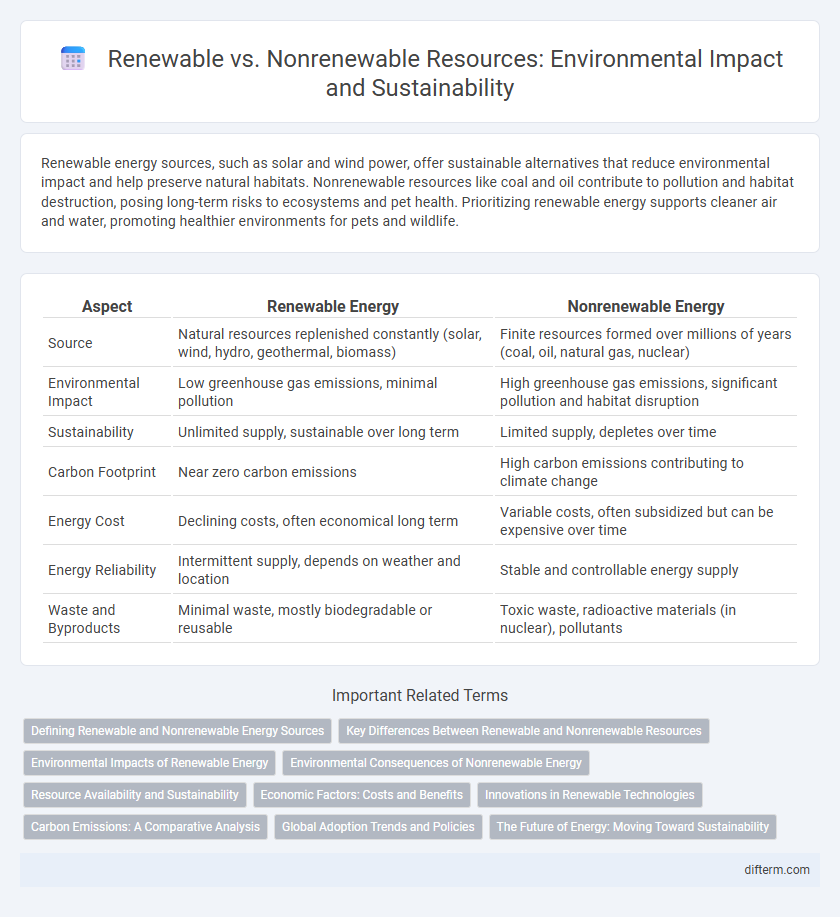Renewable energy sources, such as solar and wind power, offer sustainable alternatives that reduce environmental impact and help preserve natural habitats. Nonrenewable resources like coal and oil contribute to pollution and habitat destruction, posing long-term risks to ecosystems and pet health. Prioritizing renewable energy supports cleaner air and water, promoting healthier environments for pets and wildlife.
Table of Comparison
| Aspect | Renewable Energy | Nonrenewable Energy |
|---|---|---|
| Source | Natural resources replenished constantly (solar, wind, hydro, geothermal, biomass) | Finite resources formed over millions of years (coal, oil, natural gas, nuclear) |
| Environmental Impact | Low greenhouse gas emissions, minimal pollution | High greenhouse gas emissions, significant pollution and habitat disruption |
| Sustainability | Unlimited supply, sustainable over long term | Limited supply, depletes over time |
| Carbon Footprint | Near zero carbon emissions | High carbon emissions contributing to climate change |
| Energy Cost | Declining costs, often economical long term | Variable costs, often subsidized but can be expensive over time |
| Energy Reliability | Intermittent supply, depends on weather and location | Stable and controllable energy supply |
| Waste and Byproducts | Minimal waste, mostly biodegradable or reusable | Toxic waste, radioactive materials (in nuclear), pollutants |
Defining Renewable and Nonrenewable Energy Sources
Renewable energy sources, such as solar, wind, hydro, and geothermal, are naturally replenished on a human timescale, making them sustainable and environmentally friendly alternatives. Nonrenewable energy sources, including coal, oil, natural gas, and nuclear energy, form over millions of years and are finite, leading to depletion and environmental concerns like greenhouse gas emissions. Understanding the fundamental differences in resource availability and environmental impact is critical for transitioning to sustainable energy systems and reducing carbon footprints.
Key Differences Between Renewable and Nonrenewable Resources
Renewable resources, such as solar, wind, and hydro energy, replenish naturally within a short time frame, ensuring sustainable availability. Nonrenewable resources, including coal, oil, and natural gas, form over millions of years and are finite, leading to depletion with continuous use. The environmental impact of renewable resources is significantly lower, producing minimal greenhouse gases compared to the high emissions and pollution associated with extracting and consuming nonrenewable resources.
Environmental Impacts of Renewable Energy
Renewable energy sources, such as solar, wind, and hydroelectric power, generate electricity with significantly lower greenhouse gas emissions compared to fossil fuels, reducing air pollution and mitigating climate change. These energy systems minimize water usage and habitat disruption relative to nonrenewable sources, promoting biodiversity preservation. However, the production and disposal of renewable energy technologies require careful management to prevent resource depletion and environmental contamination.
Environmental Consequences of Nonrenewable Energy
Nonrenewable energy sources such as coal, oil, and natural gas contribute significantly to greenhouse gas emissions, driving climate change and global warming. The extraction and burning of these fossil fuels lead to air and water pollution, habitat destruction, and increased carbon footprint. In contrast, renewable energy sources offer cleaner alternatives that reduce environmental degradation and promote sustainable energy development.
Resource Availability and Sustainability
Renewable resources such as solar, wind, and hydro are naturally replenished, offering sustainable energy solutions without depleting the Earth's reserves. Nonrenewable resources like coal, oil, and natural gas face finite availability, leading to environmental degradation and long-term depletion concerns. Sustainable energy strategies prioritize maximizing renewable resource use to reduce carbon emissions and preserve ecological balance.
Economic Factors: Costs and Benefits
Renewable energy sources such as solar and wind have higher upfront installation costs but offer lower long-term operational expenses and reduced fuel dependence, leading to significant economic savings over time. Nonrenewable sources like coal and natural gas often provide cheaper immediate energy output but incur substantial environmental remediation costs and price volatility due to resource depletion. Investing in renewables stimulates job creation and sustainability, while reliance on nonrenewables risks economic instability caused by fluctuating fuel prices and regulatory penalties.
Innovations in Renewable Technologies
Advancements in solar photovoltaic efficiency have significantly increased energy conversion rates, making solar power more cost-effective and accessible worldwide. Innovations in wind turbine design, such as larger rotor diameters and bladeless models, are enhancing energy capture even in low-wind areas. Breakthroughs in battery storage technology, including solid-state batteries, are improving the reliability and scalability of renewable energy systems, accelerating the transition away from fossil fuels.
Carbon Emissions: A Comparative Analysis
Renewable energy sources such as solar, wind, and hydroelectric power produce negligible carbon emissions compared to nonrenewable sources like coal, oil, and natural gas, which release significant amounts of CO2 contributing to global warming. Studies reveal that coal-fired power plants emit approximately 2.2 pounds of CO2 per kilowatt-hour, while solar panels generate less than 0.05 pounds over their entire lifecycle. Transitioning to renewables can reduce greenhouse gas emissions by up to 80%, playing a crucial role in mitigating climate change and promoting sustainable development.
Global Adoption Trends and Policies
Countries worldwide are accelerating the adoption of renewable energy sources such as solar, wind, and hydropower due to climate commitments and decreasing technology costs. Policies like the European Green Deal and the U.S. Inflation Reduction Act promote clean energy investments, phasing out fossil fuels and incentivizing carbon reduction. Nonrenewable energy remains significant in global energy mixes, but shifting regulations and growing sustainability goals drive a steady decline in coal, oil, and natural gas dependence.
The Future of Energy: Moving Toward Sustainability
Renewable energy sources such as solar, wind, and hydroelectric power are critical for reducing carbon emissions and combating climate change, offering sustainable alternatives to finite fossil fuels like coal, oil, and natural gas. Advancements in energy storage technologies and smart grids enhance the reliability and efficiency of renewable systems, making them increasingly viable for global energy demands. Transitioning to a low-carbon economy hinges on policy support, investment in green infrastructure, and widespread adoption of clean energy innovations to secure a sustainable future.
renewable vs nonrenewable Infographic

 difterm.com
difterm.com